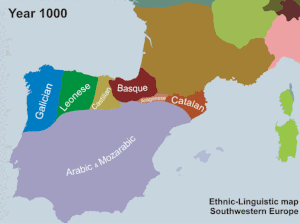
Arabic is a Central Semitic language of the Afroasiatic language family spoken primarily in the Arab world. The ISO assigns language codes to 32 varieties of Arabic, including its standard form of Literary Arabic, known as Modern Standard Arabic, which is derived from Classical Arabic. This distinction exists primarily among Western linguists; Arabic speakers themselves generally do not distinguish between Modern Standard Arabic and Classical Arabic, but rather refer to both as al-ʿarabiyyatu l-fuṣḥā or simply al-fuṣḥā (اَلْفُصْحَىٰ).

The Mozarabs, or more precisely Andalusi Christians, were the Christians of al-Andalus, or the territories of Iberia under Muslim rule from 711 to 1492. Following the Umayyad conquest of the Visigothic Kingdom in Hispania, the Christian population of much of Iberia came under Muslim control.
A kharja or kharjah, is the final refrain of a muwashshah, a lyric genre of al-Andalus written in Arabic or Andalusi Romance ("Mozárabic").

Al-Andalus was the Muslim-ruled area of the Iberian Peninsula. The term is used by modern historians for the former Islamic states in modern-day Gibraltar, Portugal, Spain, and Southern France. The name describes the different Muslim states that controlled these territories at various times between 711 and 1492. At its greatest geographical extent, it occupied most of the peninsula and part of present-day southern France (Septimania) under Umayyad rule. These boundaries changed constantly through a series of conquests Western historiography has traditionally characterized as the Reconquista, eventually shrinking to the south and finally to the Emirate of Granada.
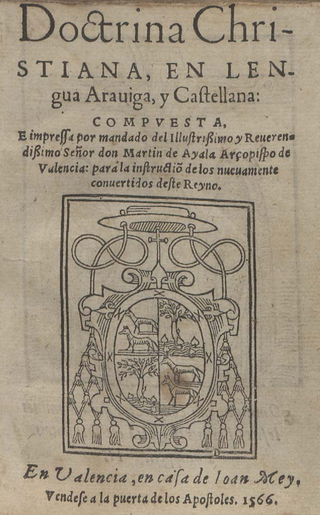
Andalusi Arabic or Andalusian Arabic was a variety or varieties of Arabic spoken mainly from the 9th to the 15th century in Al-Andalus, the regions of the Iberian Peninsula, respectively modern Spain until the late-15th century, and modern Portugal until the mid-13th century under Muslim rule. It became an extinct language in Iberia after the expulsion of the Moriscos, which took place over a century after the Granada War by the Catholic Monarchs of Spain. Once widely spoken in Iberia, the expulsions and persecutions of Arabic speakers caused an abrupt end to the language's use on the peninsula. It continued to be spoken to some degree in North Africa after the expulsion, although Andalusi speakers rapidly assimilated into the Maghrebi communities to which they fled.

Aljamiado or Aljamía texts are manuscripts that use the Arabic script for transcribing European languages, especially Romance languages such as Old Spanish or Aragonese. This alphabet is also called the Morisco alphabet.
The Portuguese language developed in the Western Iberian Peninsula from Latin spoken by Roman soldiers and colonists starting in the 3rd century BC. Old Portuguese, also known as Medieval Galician, began to diverge from other Romance languages after the fall of the Western Roman Empire and the Germanic invasions, also known as barbarian invasions, in the 5th century, and started appearing in written documents around the 9th century. By the 13th century, Galician-Portuguese had its own literature and began to split into two languages. However, the debate of whether Galician and Portuguese are nowadays varieties of the same language, much like American English or British English, is still present. In all aspects—phonology, morphology, lexicon and syntax—Portuguese is essentially the result of an organic evolution of Vulgar Latin with some influences from other languages, namely the native Gallaecian and Lusitanian languages spoken prior to the Roman domination.
Muwashshah is the name for both an Arabic poetic form and a musical genre. The poetic form consists of a multi-lined strophic verse poem written in classical Arabic, usually consisting of five stanzas, alternating with a refrain with a running rhyme. It was customary to open with one or two lines which matched the second part of the poem in rhyme and meter; in North Africa poets ignore the strict rules of Arabic meter while the poets in the East follow them. The musical genre of the same name uses muwaššaḥ texts as lyrics, still in classical Arabic. This tradition can take two forms: the waṣla of the Mashriq and the Arab Andalusi nubah of the western part of the Arab world.

The Emirate of Córdoba or Umayyad Emirate of Córdoba was a medieval Islamic kingdom in the Iberian Peninsula.
Muladí were the native population of the Iberian Peninsula who adopted Islam after the Muslim conquest of the Iberian Peninsula in the early 8th century. The demarcation of muladíes from the population of Arab and Berber extraction was relevant in the first centuries of Islamic rule, however, by the 10th century, they diluted into the bulk of the society of al-Andalus. In Sicily, Muslims of local descent or of mixed Arab, and Sicilian origin were also sometimes referred to as Muwallad. They were also called Musalimah ('Islamized'). In broader usage, the word muwallad is used to describe Arabs of mixed parentage, especially those not living in their ancestral homelands.
Arabic influence on the Spanish language overwhelmingly dates from the Muslim era of the Iberian Peninsula between 711 and 1492. The influence results mainly from the large number of Arabic loanwords and derivations in Spanish, plus a few other less obvious effects.

The language known today as Spanish is derived from spoken Latin, which was brought to the Iberian Peninsula by the Romans after their occupation of the peninsula that started in the late 3rd century BC. Today it is the world's 4th most widely spoken language, after English, Mandarin Chinese and Hindi. Influenced by the peninsular hegemony of Al-Andalus in the early middle ages, Hispano-Romance varieties borrowed substantial lexicon from Arabic. Upon the southward territorial expansion of the Kingdom of Castile, Hispano-Romance norms associated to this polity displaced both Arabic and the Mozarabic romance varieties in the conquered territories, even though the resulting speech also assimilated features from the latter in the process. The first standard written norm of Spanish was brought forward in the 13th century by Alfonso X the Wise, probably drawing from the speech of the upper classes of Toledo. Features associated with the Castilian patterns of Hispano-Romance also spread west and east to the kingdoms of León and Aragón for the rest of the middle ages, owing to the political prestige achieved by the Kingdom of Castile in the peninsular context and to the lesser literary development of their vernacular norms. From the 1560s onward the standard written form followed Madrid's.
Arabic has had a great influence on other languages, especially in vocabulary. The influence of Arabic has been most profound in those countries visited by Islam or Islamic power.

The Chronicle of 754 is a Latin-language history in 95 sections, written by an anonymous Mozarab (Christian) chronicler in Al-Andalus. The Chronicle contains the earliest known reference in a Latin text to "Europeans" (europenses), whom it describes as having defeated the Saracens at the battle of Tours in 732.
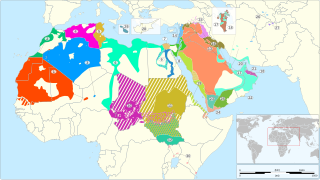
Varieties of Arabic are the linguistic systems that Arabic speakers speak natively. Arabic is a Semitic language within the Afroasiatic family that originated in the Arabian Peninsula. There are considerable variations from region to region, with degrees of mutual intelligibility that are often related to geographical distance and some that are mutually unintelligible. Many aspects of the variability attested to in these modern variants can be found in the ancient Arabic dialects in the peninsula. Likewise, many of the features that characterize the various modern variants can be attributed to the original settler dialects as well as local native languages and dialects. Some organizations, such as SIL International, consider these approximately 30 different varieties to be separate languages, while others, such as the Library of Congress, consider them all to be dialects of Arabic.

Muslims, Christians, and Jews co-existed for over seven centuries in the Iberian Peninsula during the era of Al-Andalus states. The degree to which the Christians and the Jews were tolerated by their Muslim rulers is a subject widely contested among historians. The history of Al-Andalus indicates that Muslims, Christians, and Jews who lived within Al-Andalus had relatively peaceful relations, with the exception of a few scattered revolts, and times of religious persecution. The great amount of cultural and social interaction that took place between these three distinct social and religious groups led to the creation of a unique and diverse culture that continued to flourish even after the Reconquista.
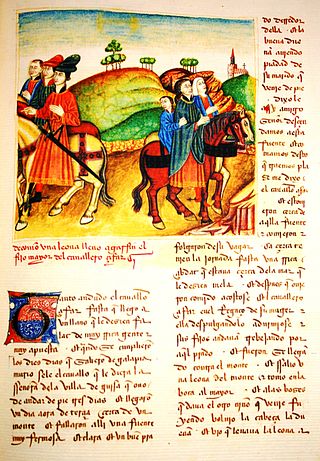
Medieval Spanish literature consists of the corpus of literary works written in Old Spanish between the beginning of the 13th and the end of the 15th century. Traditionally, the first and last works of this period are taken to be respectively the Cantar de mio Cid, an epic poem whose manuscript dates from 1207, and La Celestina (1499), a work commonly described as transitional between the Middle Ages and the Renaissance.
Hafs ibn Albar al-Qūṭī, commonly known as al-Qūṭī or al-Qurṭubî, was a 9th–10th Century Visigothic Christian count, theologian, translator and poet, often memorialised as the 'Last of the Goths'. He was a descendant of Visigothic royalty and held a position of power over the Christians of his region. He was possibly a priest or censor, but many scholars take him to be a layman. He describes himself as ignorant of the sacred sciences, and constantly allowed his works to be checked and commented on by those he called "best in their religion and a bright light in the sacred sciences", claiming that "all of them know what I do not know".
The literature of al-Andalus, also known as Andalusi literature, was produced in al-Andalus, or Islamic Iberia, from the Muslim conquest in 711 to either the Catholic conquest of Granada in 1492 or the expulsion of the Moors ending in 1614. Andalusi literature was written primarily in Arabic, but also in Hebrew, Latin, and Romance.
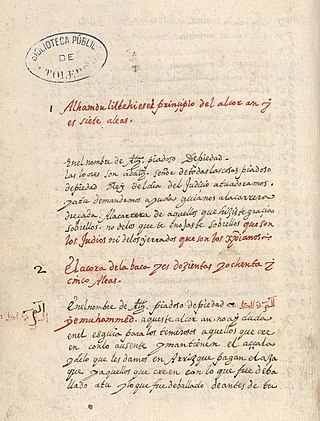
The Quran of Toledo is a 1606 manuscript copy of the Quran translated completely into a variety of Castilian in Latin script, probably in Villafeliche. It is held as manuscrito 235 at the Biblioteca de Castilla-La Mancha in Toledo. It is the only surviving full vernacular translation of the Quran from the period, although it includes exegetical commentaries and it is by no means a faithful word-for-word translation of the Quranic text.
